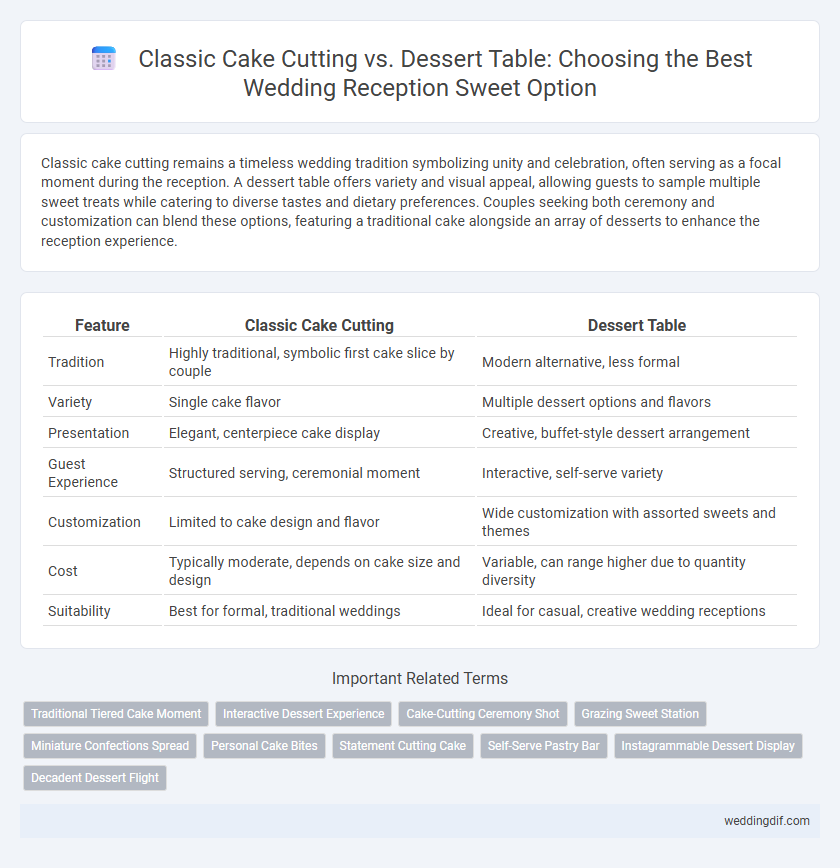Classic cake cutting remains a timeless wedding tradition symbolizing unity and celebration, often serving as a focal moment during the reception. A dessert table offers variety and visual appeal, allowing guests to sample multiple sweet treats while catering to diverse tastes and dietary preferences. Couples seeking both ceremony and customization can blend these options, featuring a traditional cake alongside an array of desserts to enhance the reception experience.
Table of Comparison
| Feature | Classic Cake Cutting | Dessert Table |
|---|---|---|
| Tradition | Highly traditional, symbolic first cake slice by couple | Modern alternative, less formal |
| Variety | Single cake flavor | Multiple dessert options and flavors |
| Presentation | Elegant, centerpiece cake display | Creative, buffet-style dessert arrangement |
| Guest Experience | Structured serving, ceremonial moment | Interactive, self-serve variety |
| Customization | Limited to cake design and flavor | Wide customization with assorted sweets and themes |
| Cost | Typically moderate, depends on cake size and design | Variable, can range higher due to quantity diversity |
| Suitability | Best for formal, traditional weddings | Ideal for casual, creative wedding receptions |
Classic Cake Cutting Tradition: Timeless Elegance
The Classic Cake Cutting tradition at weddings symbolizes timeless elegance, serving as a cherished moment that highlights the couple's unity and shared future. This ritual often features a beautifully designed tiered cake, reinforcing the event's sophistication and providing a focal point for photography and guest interaction. Preserving this custom enhances the wedding atmosphere with a sense of heritage and formal celebration.
The Rise of Dessert Tables at Modern Weddings
Dessert tables have surged in popularity at modern weddings, offering a visually appealing and customizable alternative to the traditional classic cake cutting. Couples increasingly choose dessert tables to showcase a variety of sweets like macarons, cupcakes, and mini tarts, enhancing guest experience with diverse flavors and interactive presentation. This trend reflects a shift toward personalization and abundance, making dessert tables a centerpiece that complements contemporary wedding aesthetics.
Symbolism Behind the Cake Cutting Ceremony
The cake cutting ceremony symbolizes unity and the first joint task of the newlyweds, representing their commitment to support and nurture each other throughout marriage. Classic cake cutting centers on tradition and the shared promise of prosperity, while a dessert table offers diverse sweet choices reflecting personalization and abundance. This ritual underscores the couple's partnership and the beginning of their shared journey, deeply rooted in wedding customs.
Variety and Customization with Dessert Tables
Dessert tables offer greater variety and customization compared to classic cake cutting, featuring an assortment of sweets such as cupcakes, macarons, and mini tarts tailored to couple preferences. This option caters to diverse guest tastes, providing gluten-free, vegan, and themed desserts that enhance the wedding experience. Unlike the traditional single-flavor cake, dessert tables create a visually appealing and interactive reception focal point with personalized displays.
Guest Experience: Single Slice vs Sweet Selections
Classic cake cutting offers guests a memorable moment centered around a single, elegantly crafted slice symbolizing celebration tradition. Dessert tables provide a diverse array of sweet selections, enhancing guest experience with variety tailored to different tastes and dietary preferences. This choice impacts how guests savor the event, balancing ceremonial charm with personalized indulgence.
Visual Impact: Statement Cake vs Dessert Display
The classic cake cutting creates a focal point with a single, often intricately designed statement cake that serves as a centerpiece for the wedding reception. In contrast, a dessert table offers a visually dynamic display featuring an array of desserts in various colors, shapes, and heights, enhancing guest interaction and photo opportunities. Both options elevate the ambiance, but the dessert table provides a more versatile and engaging visual experience compared to the traditional statement cake.
Budget Considerations: Cake Cutting or Dessert Spread?
Classic cake cutting typically requires a single large cake, which can be more cost-effective for couples with a strict budget, as it eliminates the need for multiple desserts and varied ingredients. Dessert tables often involve a variety of sweets, increasing costs due to the need for different items, decorations, and presentation elements, making them pricier but appealing for guests seeking variety. Couples should weigh the budget impact against guest preferences, as classic cake cutting simplifies expenses while dessert tables offer a more elaborate, diverse experience.
Logistics: Serving and Space Requirements
Classic cake cutting requires minimal space and simple utensils for serving, making it easy to manage and quickly distribute slices to guests. Dessert tables demand more room for display and a variety of serving tools, often necessitating additional staff to assist with portioning and replenishment. Efficient planning for dessert tables ensures smooth guest flow and prevents congestion in the reception area.
Dietary Flexibility: Accommodating All Guests
Classic cake cutting offers a traditional centerpiece with limited flavor and dietary options, often requiring additional desserts to accommodate gluten-free, vegan, or allergen-sensitive guests. Dessert tables provide a diverse selection of sweets, including vegan, nut-free, and sugar-free treats, ensuring all guests can enjoy a personalized, inclusive experience. Prioritizing dietary flexibility at weddings enhances guest satisfaction and reflects thoughtful planning for diverse preferences and restrictions.
Choosing the Right Option for Your Wedding Style
Selecting between a classic cake cutting and a dessert table depends largely on your wedding style and guest preferences. Classic cake cutting offers a timeless, elegant moment that is perfect for traditional ceremonies, while a dessert table provides variety and a modern, interactive experience suitable for contemporary weddings. Consider factors like guest engagement, presentation, and overall theme to ensure your choice complements the atmosphere of your big day.
Classic Cake Cutting vs Dessert Table for wedding. Infographic

 weddingdif.com
weddingdif.com